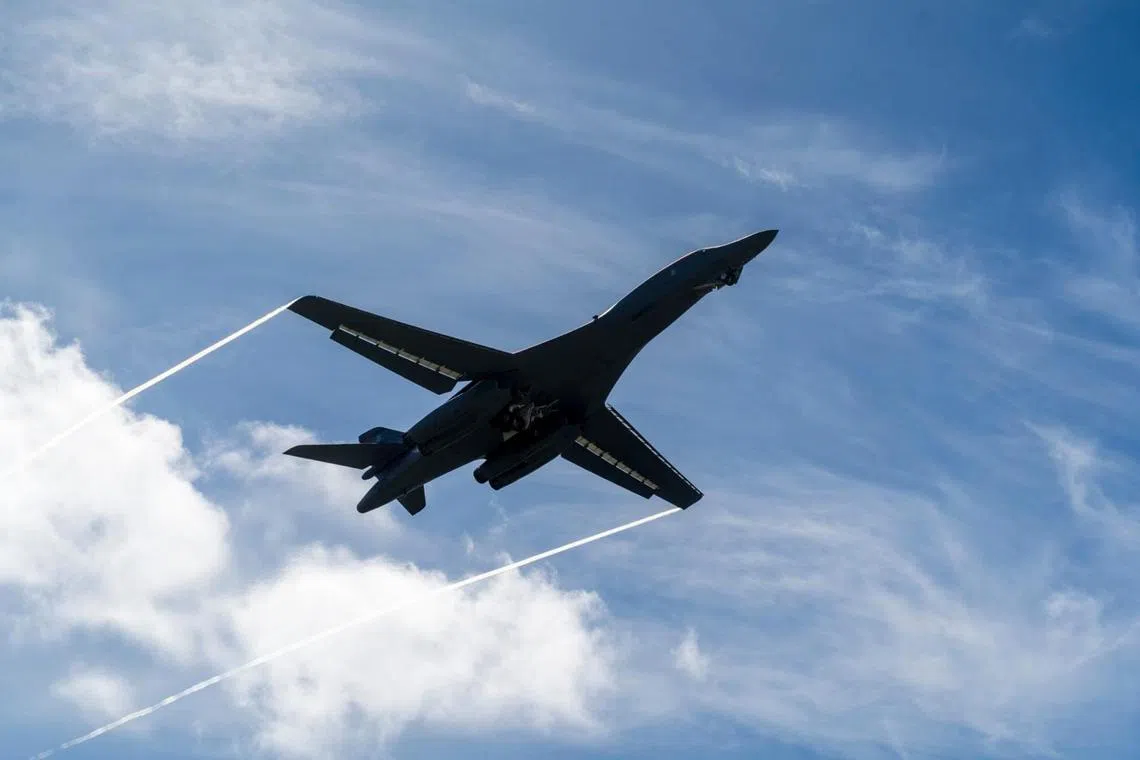North Korea fires ballistic missiles as US deploys B-1B strategic bomber to military drill
Sign up now: Get insights on Asia's fast-moving developments

This is the first time the B-1B strategic bomber has been deployed in US-South Korean drills since 2017.
PHOTO: U.S. PACIFIC AIR FORCE/FACEBOOK
Follow topic:
SEOUL - North Korea fired four short-range ballistic missiles into the western sea on Saturday, South Korea’s military said, as Seoul and Washington ended a high-profile six-day military exercise.
North Korea has launched a series of missiles this week, including a possible failed intercontinental ballistic missile (ICBM), drawing condemnation from Washington, Seoul and Tokyo, and raising speculation it could be preparing to resume nuclear weapons testing for the first time since 2017.
The European Union viewed the “unprecedented” number of missiles fired as “a dangerous escalation” by Pyongyang, said an EU statement issued by its foreign policy chief Josep Borrell on Saturday. It called for a global “resolute and united response”, including the full weight of United Nations sanctions.
Saturday’s launches between 11.31am and 11.59am (0231-0259 GMT) come as the United States and South Korea finished the Vigilant Storm exercise they began on Monday. The missiles flew about 130km, reaching an altitude of about 20km, Seoul said.
The allied exercise involved some 240 military aircraft and two US B-1B strategic bombers, as well as four F-16 and four F-35A fighters, according to South Korea’s Joint Chiefs of Staff.
This is the first time the B-1B has been deployed in US-South Korean drills since 2017, showing “the combined defence capabilities and determination of the Republic of Korea and the US to resolutely respond to any provocations from North Korea, and the will of the US to implement a strong commitment to extended deterrence,” the joint chiefs said in a statement.
Pyongyang on Friday demanded the United States and South Korea halt “provocative” air exercises. Pyongyang has especially condemned past deployments of US strategic weapons such as B-1Bs and aircraft carrier strike groups in times of high tension.
South Korea said it scrambled warplanes in response to 180 North Korean military flights near the countries’ shared border on Friday.
On Wednesday, North Korea fired a record 23 missiles, with one landing off the coast of South Korea for the first time, after Pyongyang threatened to take powerful measures unless Washington halts allied air exercises with South Korea.
As the tit-for-tat exchange continued through the week, Washington called for a public UN Security Council meeting on Friday, where it accused Russia and China of providing “blanket protection” to North Korea from further Security Council action.
A North Korean foreign ministry spokesman issued a statement late on Friday warning that “sustained provocation is bound to be followed by sustained counteraction,” said state media KCNA.
In recent years, the Security Council has been split on how to deal with North Korea. In May, China and Russia vetoed a US attempt to impose more UN sanctions in response to North Korean missile launches.
China’s UN Ambassador Zhang Jun said that instead of playing up tensions, the US should create conditions for the resumption of meaningful dialogue with North Korea.
“The council should play a constructive role rather than always stressing on pressure,” Mr Zhang added.
“Under the current circumstances, the council should in particular strive to mitigate confrontation, ease tensions, and promote the political settlement.”
In a joint statement to reporters after the meeting, the elected 10 members of the Security Council condemned North Korea’s missile launches and called on the body to “speak with a unified voice on this matter.” REUTERS, AFP

